O level biology exam - Study guides, Class notes & Summaries
Looking for the best study guides, study notes and summaries about O level biology exam? On this page you'll find 319 study documents about O level biology exam.
Page 4 out of 319 results
Sort by
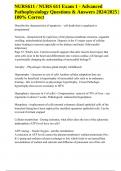
-
NURS611 / NURS 611 Exam 1 - Advanced Pathophysiology Questions & Answers 2024/2025 | 100% Correct
- Exam (elaborations) • 12 pages • 2024
-
- $16.49
- + learn more
NURS611 / NURS 611 Exam 1 - Advanced Pathophysiology Questions & Answers 2024/2025 | 100% Correct. Describe the characteristics of apoptosis. - cell death that is regulated or programmed Necrosis - characterized by rapid loss of the plasma membrane structure, organelle swelling, mitochondrial dysfunction. Hypoxia is the #1 major cause of cellular injury leading to necrosis especially to the kidneys and heart. (Myocardial infarction) Page 52: What's new: Current research supports that afte...
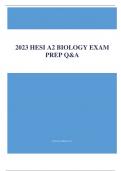
-
2023 HESI A2 BIOLOGY EXAM PREP Q&A
- Exam (elaborations) • 19 pages • 2023
- Available in package deal
-
- $14.99
- + learn more
2023 HESI A2 BIOLOGY EXAM PREP Q&A 1. 1. QUESTION A clinical researcher administered a pill with no therapeutic value to his subject. Which of the following best describes this treatment? o Experimentation o Placebo o Evaluation o Double-blind A placebo prevents the test subjects from knowing whether they are being given the real therapeutic drug or not. This helps the examiner understand the true effects of the drug. Experimentation involves a set of procedures used to test a particul...
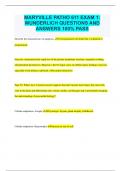
-
MARYVILLE PATHO 611 EXAM 1: WUNDERLICH QUESTIONS AND ANSWERS 100% PASS
- Exam (elaborations) • 25 pages • 2023
- Available in package deal
-
- $9.99
- + learn more
MARYVILLE PATHO 611 EXAM 1: WUNDERLICH QUESTIONS AND ANSWERS 100% PASS Describe the characteristics of apoptosis. A programmed cell death that is regulated or programmed. Necrosis: characterized by rapid loss of the plasma membrane structure, organelle swelling, mitochondrial dysfunction. Hypoxia is the #1 major cause of cellular injury leading to necrosis especially to the kidneys and heart. (Myocardial infarction) Page 52: What's new: Current research supports that after muscle heart injury...
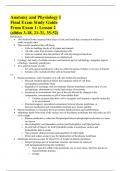
-
Anatomy and Physiology I Final Exam Study Guide From Exam 1: Lesson 2 (slides 3-18, 21-31, 35-52) Introduction
- Exam (elaborations) • 40 pages • 2023
-
- $12.49
- + learn more
Anatomy and Physiology I Final Exam Study Guide From Exam 1: Lesson 2 (slides 3-18, 21-31, 35-52) Introduction • 1665 Robert Hooke inspected thin slices of cork and found they consisted of millions of small, irregular units • This research produced the cell theory o Cells are building blocks of all plants and animals o All cells come from division of preexisting cells o Cells are smallest units that perform all vital physiological functions o Each cell maintains homeostasis at cellular...
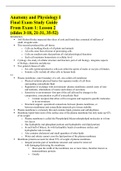
-
Anatomy and Physiology I Final Exam Study Guide From Exam 1: Lesson 2 (slides 3-18, 21-31, 35-52)
- Exam (elaborations) • 40 pages • 2023
- Available in package deal
-
- $13.49
- + learn more
Anatomy and Physiology I Final Exam Study Guide From Exam 1: Lesson 2 (slides 3-18, 21-31, 35-52) Introduction • 1665 Robert Hooke inspected thin slices of cork and found they consisted of millions of small, irregular units • This research produced the cell theory o Cells are building blocks of all plants and animals o All cells come from division of preexisting cells o Cells are smallest units that perform all vital physiological functions o Each cell maintains homeostasis at cellular...
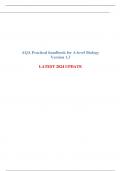
-
AQA Practical handbook for A-level Biology Version 1.3 LATEST 2024 UPDATE
- Exam (elaborations) • 162 pages • 2024
-
- $17.48
- + learn more
Contents Section Page A Introduction 4 Information about practical work for teachers B Practical work in reformed A-level Biology, Chemistry and Physics 7 C Practical skills assessment in question papers 12 D Guidelines for supporting students in practical work 18 E Use of lab books 20 F Cross-board statement on CPAC 22 G Evidence for the endorsement 31 H Questions from teachers following the first year of the practical endorsement 33 I Cross-board apparatus and techniques and AQ...
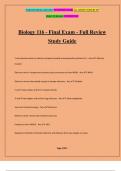
-
Biology 116 - Final Exam - Full Review Study Guide
- Exam (elaborations) • 211 pages • 2024
-
- $12.49
- + learn more
Biology 116 - Final Exam - Full Review Study Guide From electron donor to electron acceptor (usually accompanied by protons H+) - Ans:-Electron transfer Electron carrier: Accepts two electrons plus one proton to form NADH - Ans:-NAD+ Electron carriers that readily accept or donate electrons - Ans:-Shuttles C and H have similar and form nonpolar bonds O and N have higher and tend to hog electrons - Ans:-Electronegativity Source of chemical energy - Ans:-Electrons Electron carrier: Access...
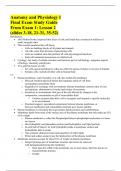
-
Anatomy and Physiology I Final Exam Study Guide From Exam 1: Lesson 2 (slides 3-18, 21-31, 35-52)
- Exam (elaborations) • 40 pages • 2023
-
- $11.99
- + learn more
Anatomy and Physiology I Final Exam Study Guide From Exam 1: Lesson 2 (slides 3-18, 21-31, 35-52) Introduction • 1665 Robert Hooke inspected thin slices of cork and found they consisted of millions of small, irregular units • This research produced the cell theory o Cells are building blocks of all plants and animals o All cells come from division of preexisting cells o Cells are smallest units that perform all vital physiological functions o Each cell maintains homeostasis at cellular...
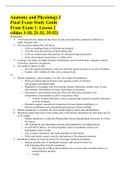
-
Anatomy and Physiology I Final Exam Study Guide From Exam 1: Lesson 2 (slides 3-18, 21-31, 35-52) Introduction
- Exam (elaborations) • 40 pages • 2023
-
- $13.49
- + learn more
Anatomy and Physiology I Final Exam Study Guide From Exam 1: Lesson 2 (slides 3-18, 21-31, 35-52) Introduction • 1665 Robert Hooke inspected thin slices of cork and found they consisted of millions of small, irregular units • This research produced the cell theory o Cells are building blocks of all plants and animals o All cells come from division of preexisting cells o Cells are smallest units that perform all vital physiological functions o Each cell maintains homeostasis at cellular...
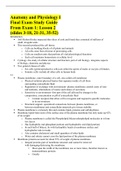
-
Anatomy and Physiology I Final Exam Study Guide From Exam 1: Lesson 2 (slides 3-18, 21-31, 35-52)
- Exam (elaborations) • 40 pages • 2023
-
- $12.49
- + learn more
Anatomy and Physiology I Final Exam Study Guide From Exam 1: Lesson 2 (slides 3-18, 21-31, 35-52) Introduction • 1665 Robert Hooke inspected thin slices of cork and found they consisted of millions of small, irregular units • This research produced the cell theory o Cells are building blocks of all plants and animals o All cells come from division of preexisting cells o Cells are smallest units that perform all vital physiological functions o Each cell maintains homeostasis at cellular...

How did he do that? By selling his study resources on Stuvia. Try it yourself! Discover all about earning on Stuvia


